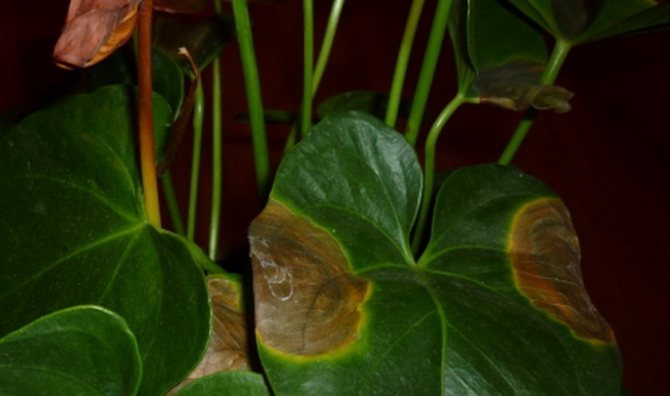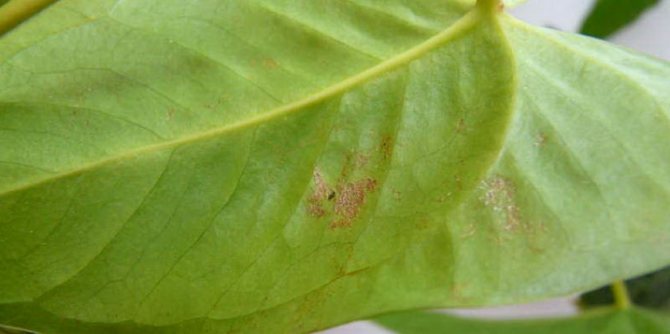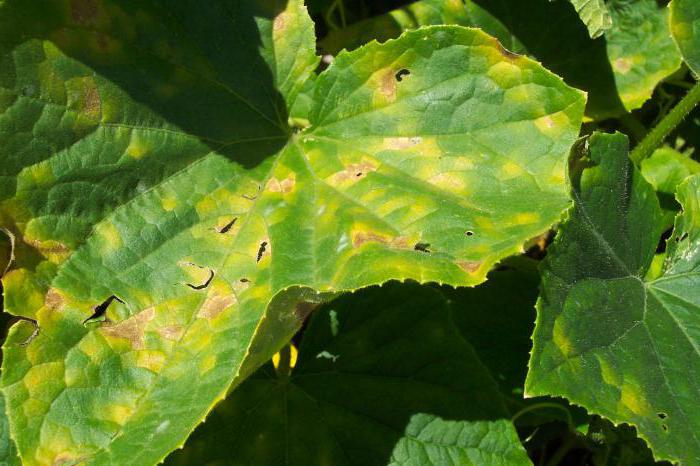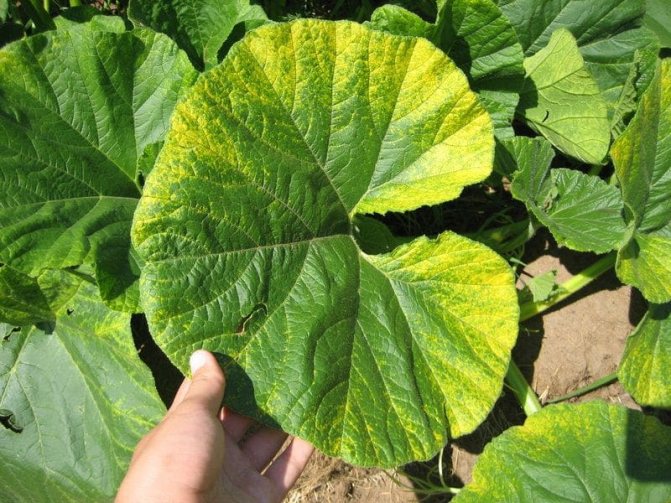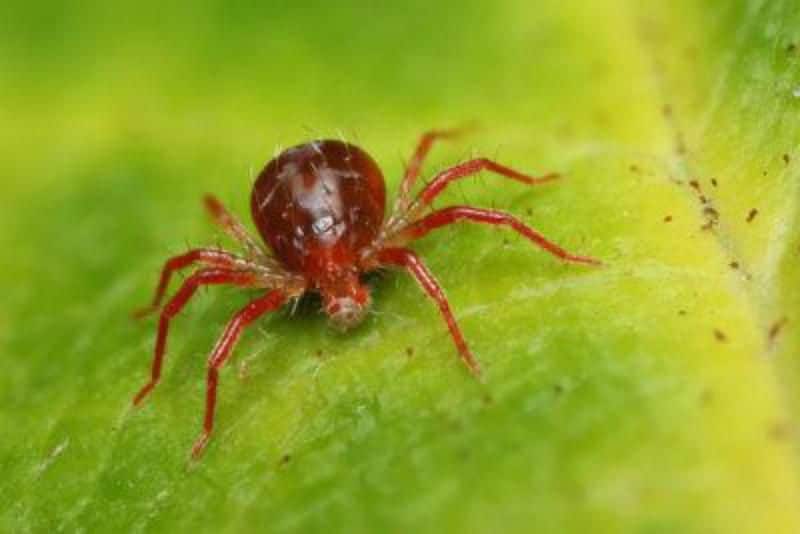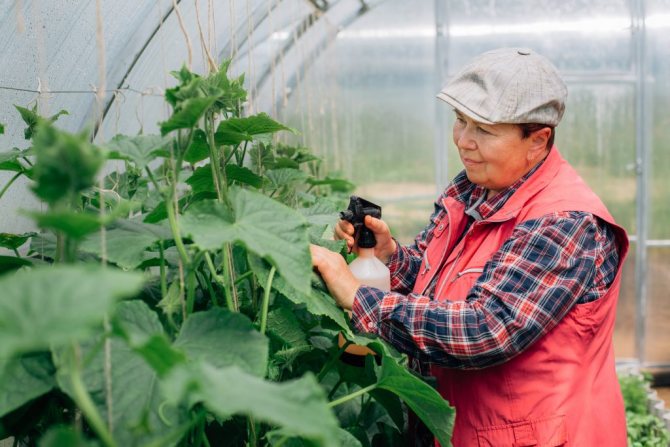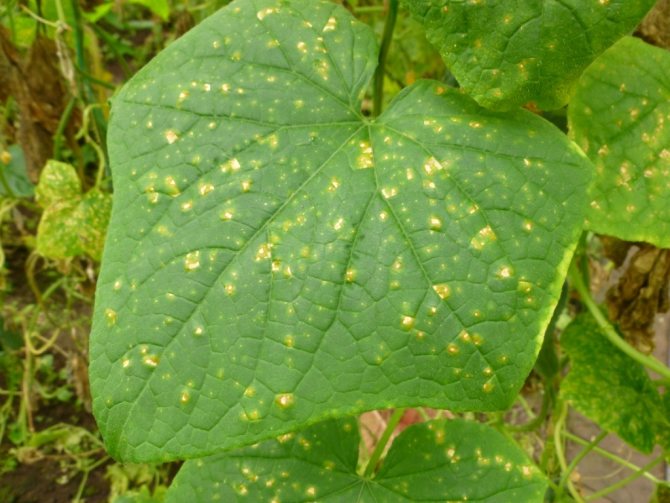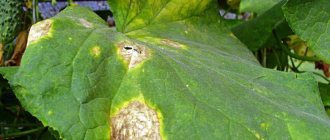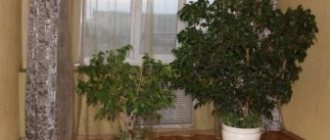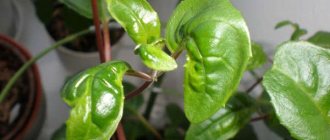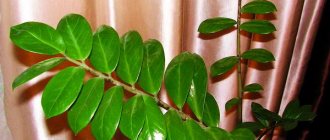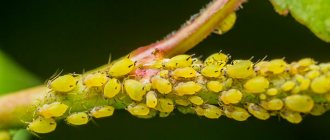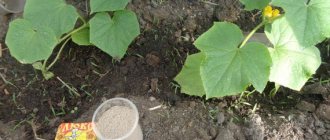Brown spots on the leaves of the ficus are a signal indicating that either one of the infections has hit the flower, or pests have attacked it. Most often, flower growers have to deal with non-infectious diseases, which were caused by the actions of the owner of the plant.
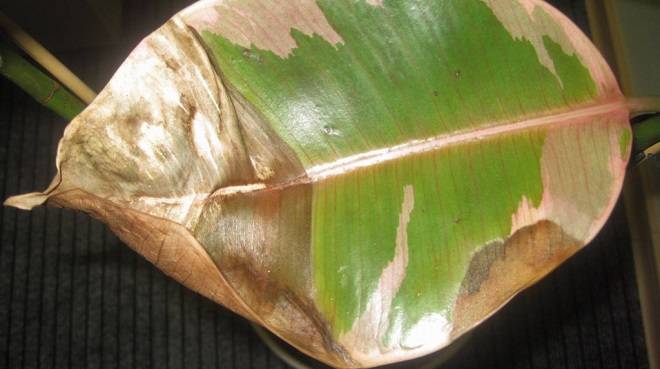
This is about:
- Not observing the temperature.
- Improper lighting.
- Dry or vice versa humid air.
- In the absence or excess of fertilizers in the soil.
- Illiterate watering.
In the case when the room is too hot, brown dots begin to appear on the leaf plates, which later dry out. In order to eliminate this, it is necessary to slightly lower the temperature. In winter, the mark on the thermometer should not exceed +23 ° C, and in summer it should be above +26 ° C.
A similar problem can appear due to too much dry air. True, in this case, the leaves begin to turn yellow and fall off en masse. Usually, such a nuisance makes itself felt during the heating season and in the summer.
Important! If the situation is not corrected, the flower will die.
So, in the summer it is not recommended to put the flowerpot on the sunny side. In the case when there is no other corner, you need to curtain the window or close the blinds so that the flower does not burn. In winter, the pot is placed as far away from heaters and batteries as possible.
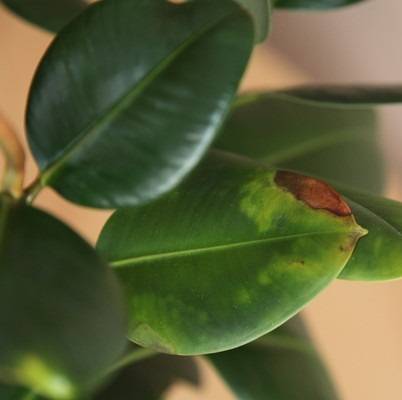

The appearance of small yellow spots on the leaves, which then begin to fall off, may indicate a lack of nutrients in the soil mixture.... If the florist knows for sure that the plant has not been fed for a long time, it is worth adding complex fertilizers to the substrate or transplanting the ficus into a new soil, which contains sufficient minerals.
An excess, as well as a lack of nutrients, leads to the fact that the leaves of the ficus begin to become covered with brown spots or fall off. Therefore, fertilizers must be applied strictly according to the instructions and no more than a couple of times a month.
When small specks appear on the leaves, or they begin to turn yellow at the edges, this means that the soil is flooded. In this case, it is necessary to completely stop watering and wait until the substrate dries well. It will also not be superfluous to loosen the soil. If after this the situation does not change, the condition of the root system should be assessed - it is quite possible that the roots have rotted. If this is so, then the affected roots are removed, leaving healthy ones, after which the plant is transplanted into a new pot with a complete replacement of the soil.
Overflow is bad, but the lack of moisture is detrimental to the ficus. It must be understood that in this case, not only the leaf plates suffer, but also the root system. Faced with such a problem, many growers do not know what to do, although in this case you just need to "soak" the flower pot in water for several hours, so that the soil mixture is well wet.
Important! Ficus trees are a special species that sheds their leaves as the bush ages.
In this case, the old sheet plates are replaced by new ones, so there is nothing wrong with that.
Fungal diseases of ficus
Ficus diseases are not only non-infectious, but also fungal and viral.


The most common are:
- gray rot;
- sooty mushroom;
- cercosporosis;
- anthracnose;
- root rot.
Regardless of the problem, the leaves are stained, yellow, fall off, or turn to dust.It is very important to recognize the problem in time and start fixing it.
Gray rot
It is quite simple to define this disease, because mold can be seen on the leaves. The leaf plates are first covered with brown spots, then darken and fall off.
Given that the fungus takes root well in a humid and warm room, it is necessary to ventilate, remove the affected leaves and spray the flower with fungicidal agents.
Sooty mushroom
Usually, this type of fungus develops against the background of damage to the flower by the scabbard and aphids. At the same time, the leaves become dark and are covered with a black bloom. To fix the problem, you need to start by identifying the root cause.
Cercosporosis
Brown and black dots on the leaves may indicate cercosporiasis, which actively reproduces in high humidity. Over time, the leaf plates fall off en masse. In order to save the plant, the affected leaves should be cut off, and the flower should be sprayed with antifungal agents.
Anthracnose
It is difficult to confuse this disease with any other. It manifests itself as rusty spots, in the place of which holes appear.... It is necessary to eliminate the problem as soon as possible so that the flower does not die. You need to treat the plant with fungicides.
Root rot
Excessive watering of the flower leads to a problem, as a result of which the roots begin to rot. In this case, on the leaves, you can observe the appearance of specks of different colors, their yellowing, and then dropping.
If, when examining the roots, it turned out that there are no healthy ones, then the ficus should be thrown out. If there is, then the decayed parts are removed, and the plant is transplanted into a new flowerpot and continue to study the issue of proper watering so that such problems do not arise in the future.
Useful Tips
Some of the drugs recommended above (for example, the last two) may not be available in gardening stores due to the fact that the drug is not yet approved for use in the private sector.
In such cases, it remains to cooperate with neighbors, other acquaintances and himself order online or through entrepreneurs and supply organizations or agricultural enterprises one package for several people.
TIP... For the alternation of drugs in cases of resistance to some of them, it is possible to suggest the use of some drugs that may be effective for phylostictosis or other diseases, but are not yet recommended in this capacity, for example, Alirin-B, Pharmayod.
The fact is that such drugs have a fairly broad effect and are practically safe.
Harmful insects - the cause of ficus disease
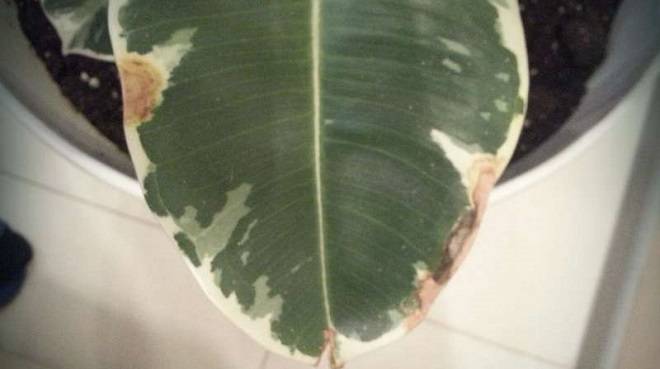

It is not necessary if brown spots appear on the leaves of the ficus - this is a symptom of a fungal disease. It is possible that pests have started on the plant.
Today there are a great many of them. However, the most common are:
- aphid;
- shield;
- mealybug;
- spider mite;
- thrips;
- nematodes.
Aphid
When aphids appear on the ficus, the leaves begin to turn yellow, deform and fall off. The negative point is that the sticky base of the affected leaf attracts other pests. You can fix the problem by washing the leaves with soapy water and treating them with insecticides.
Shield
If the flower is struck by a scabbard, then brown convex spots will be noticeable on the seamy side of the leaf plate. It is possible to eliminate the problem by treating the flower with the same soap solution, and then using Aktellik.
Mealybug
The mealybug does not leave dark spots after itself, but it is detrimental to the flower, since it sucks out all the juices from the plant. The parasites are removed by hand by peeling it off the plant. Next, you will need to treat the flower well with tobacco solution or soapy water. If the ficus is severely affected, then only spraying with Confidorm will save the situation. The manipulation is carried out every 10 days.
Spider mite
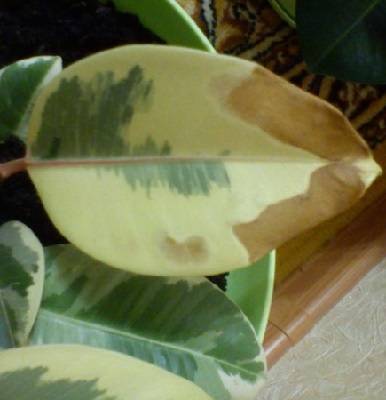

There is no need to explain for a long time why the spider mite "settles" on the plant. The reason lies in the warm and dry environment in which the plant grows. When a flower is damaged by a pest, brown and brown spots remain on the leaf plates. Lowering the temperature in the room, spraying with water, soapy water will save the situation.
Thrips
These insects can be identified by brown, white and yellow spots on the leaves. You can get rid of the parasite if you spray the flower with Aktara, Aktilik, Tanrek or a solution of pyrethrum.
Nematodes
Nematodes are harmful to the root system. You can notice the parasites if you inspect the roots, on which white growths appear. You can save the flower. To do this, the roots must be immersed in an insecticidal solution for a couple of hours, and then the flower must be transplanted into a new pot with a new substrate.
Leaves are the main indicator that the ficus is sick. Once you find the root of the problem, you need to address it immediately.


Many indoor plant lovers sooner or later face problems associated with the deterioration of the health and decorative value of potted flowers. If appeared leaf spots of one or another species from your flower collection, it is necessary to determine the cause of damage to the leaf blades as soon as possible.
It is possible that the appearance of spots on the leaves is caused by sunburn and it is necessary to shade the flower from direct sunlight. Usually, such lesions appear in the summer - yellowish or bu is clearly visible on the leaves. Usual infections causing leaf spot.
Usually, beginner growers are faced with damage to plants by pests or diseases, who make violations in the process of caring for 'green pets' at home. Therefore, it is important to carefully inspect all potted flowers as often as possible in order to promptly take action if spots are found on the leaves. It is much easier to deal with pests and diseases at the initial stage of appearance than after the defeat of large areas, when the chances of saving the plant become less and less. ♦ WHY DO BLACK SPOTS APPEAR ON FLOWER LEAVES?
◉ fungal disease phyllostictosis (brown spot). At the initial stage of the lesion, points of dark purple and black appear. Gradually, the dots increase in size and turn into brown or black spots on the leaves;
◉ fungal disease septoria. At first, you can find on the leaves small oval spots of light gray color with a brownish border. Gradually, the affected areas of the leaves increase in size and black spots appear in the central part, consisting of spores of the Septoria fungus. Then the mycelium spreads over the entire drying sheet and the color of the leaf blade becomes brown;
◉ fungal disease powdery mildew. At the initial stage of the disease, small spots with a grayish bloom appear. The mycelium rapidly expands, small spots merge, darken and black spots with spores may appear closer to the center of the leaf blade;
◉ sooty fungus. The mob often appears on the secretions (honeydew) of such pests as aphids, mealybugs, scale insects, thrips. A sticky honeydew remains on the leaves, and then black bloom and small dark or black spots appear;
◉ Another dangerous mycosis is black rot. At first, dark brown spots with yellowish concentric rings may appear. Gradually, the spots increase in size, darken and the entire leaf literally turns black;
◉ bacteriosis bacterial rot. More often appears on the fleshy leaves of indoor plants. At the initial stage of the disease, small spots of brown or black color can be found. Gradually, the tissue of the leaf softens and necrosis of the areas of the leaf blade occurs.
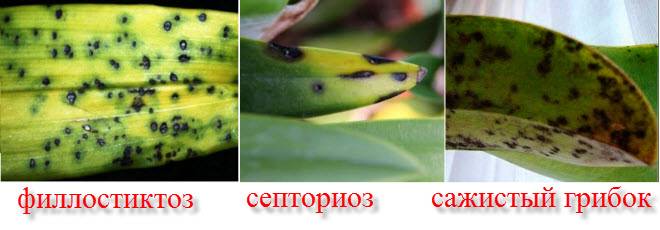

- photo: black spots on the leaves of indoor plants
♦ WHY DO YELLOW SPOTS APPEAR ON FLOWER LEAVES?
❂ improper plant care (watering with cold water, overflow and stagnation of water in the root system, incorrect fertilizing, unsuitable soil mixture). At first, shapeless yellow spots may appear on the lower leaves, yellowish dots along the veins. Due to waterlogging or stagnant water in the roots, blurry yellowish spots appear on thin leaf blades;
❂ drafts and prolonged airing of the room. The so-called draft spots may appear on the leaves of flowers due to hypothermia of the root socket. Yellow spots of irregular or blurred shape are scattered throughout the leaf blade;
❂ sunburn. Sunburns can occur after watering or spraying where droplets on the leaves act like lenses. On the leaves are noticeable round or oval yellow spots with a reddish-brown rim;
❂ fungal disease peronosporosis (downy mildew). On the upper side of the leaf blade, grayish-yellow spots with a blurred outline appear. The mycelium quickly grows in size and the spots merge;
❂ bacteriosis bacterial spotting. At first, glassy spots with a vague rim appear. Soon, these spots on the leaves turn yellow, and then increase in size, turn black and the leaf dries;
❂ pests of indoor plants suck sap from tissues. At first, you can find small yellowish dots on the leaves. Gradually, the pests multiply, the dots become more and more and they increase in size, turning into yellow spots.
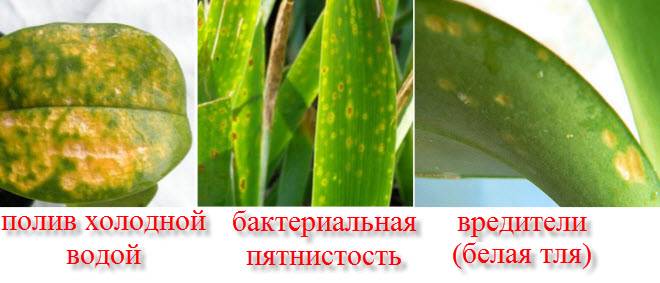

- photo: yellow spots on the leaves of indoor plants
♦ WHY DO WHITE SPOTS APPEAR ON FLOWER LEAVES? ◎ fungal disease powdery mildew. First, a grayish bloom appears, which is easily removed mechanically. Then the entire leaf becomes covered with shapeless white spots, which eventually turn dark brown or brown; ◎ gray mold fungal disease. In the initial stage, it usually appears on damaged and withered leaves in the form of shapeless brownish or brown spots. But after a while, you can find white spots - this is a plaque, under which the color of the spots is rusty or brown; ◎ damage to the plant with thrips. The areas of the leaf blade affected by pests are covered with white spots. If you look closely, you can also find tiny excrement of black thrips in the same place.


- photo: white spots on the leaves of indoor plants
♦ SPOTS ON LEAVES IN DIFFERENT TYPES OF FLOWERS:
⊛ Anthurium. Irregularities in the watering regime lead to the appearance of yellow or rusty spots on the leaves. An improperly prepared soil mixture, which decomposes and cakes, can lead to the appearance of blurred yellow spots, and the leaves themselves are deformed. Anthracnose often infects Andre's anthurium (Man's happiness), which leads to the appearance of dark spots and drying of the leaves. Frequent drafts and low temperatures lead to the appearance of blackheads and small spots. Small translucent dark spots on the leaf blade indicate a possible defeat of anthurium by a spider mite. And numerous yellowish spots against the background of deformed leaves may be the result of the activity of aphids, sucking out the juices of anthurium.
⊛ Orchid (phalaenopsis, dendrobium). If dry brownish or brown spots appear on the leaves, then most likely this is a defeat by the fungus Cladosporium Orchideorum. If you constantly water the orchid with cold water, then you can provoke the appearance of uneven depressed yellow spots - this is the so-called death of leaf tissue cells (Mesophyll collapse).Circles and yellow spots of Cercospora bacterial spots may appear on the leaves at high levels of air humidity against a background of elevated temperatures. The fungus Phyllostictina Pyriformis causes small yellow and black spots on the top of the leaf - and especially around the edges. The appearance of black spots of different sizes can cause chlorosis if the orchid is watered with unsettled running water.
⊛ Ficuses (Benjamin, rubbery elastica). The upper part of the leaf blade is covered with small yellowish and dark spots, a cobweb is visible between the shoots and leaves - this is a spider mite lesion. Sticky secretions of pests (scale insects, thrips, mealybugs) can provoke the appearance of a sooty fungus on the leaves. Gray rot causes darkening of the leaves and the appearance of spots with a grayish bloom on the surface. Ficus is often affected by powdery mildew, when it appears on the leaves, white spots with a bloom are clearly visible.
⊛ Saintpaulia (uzambara violets). They are very susceptible to direct sunlight, with prolonged exposure to which burns appear on the leaves in the form of oval yellow spots with a brownish central part. Cold air and constant drafts provoke the appearance of gray-beige stains of various shapes. Dark spots may appear along the edges of the lower leaves of violets if the plant has not been transplanted for a long time or the flower does not have enough potassium. Powdery mildew causes white spots with a powdery coating, and then the leaves turn brown, deformed and fall off.
to Home Page
3.26 Copyright (C) 2008 / Copyright (C) 2007 Alain Georgette / Copyright (C) 2006 Frantisek Hliva. All rights reserved. "
bebi.lv
What other spots can appear on anthurium and why
Why geranium leaves turn yellow at home - causes and treatment
The appearance of uncharacteristic spots on the leaves of anthurium indicates a disease of the species. It is possible to understand the cause and decide on the treatment only after a thorough examination of the leaf plate.
Yellow spots
Yellowing of the leaf plate can occur when the plant is infected with chlorosis. It appears due to the lack of the following trace elements: iron and magnesium. For treatment, the damaged leaves should be removed and a complex fertilizer enriched with the necessary substances should be urgently introduced into the soil.
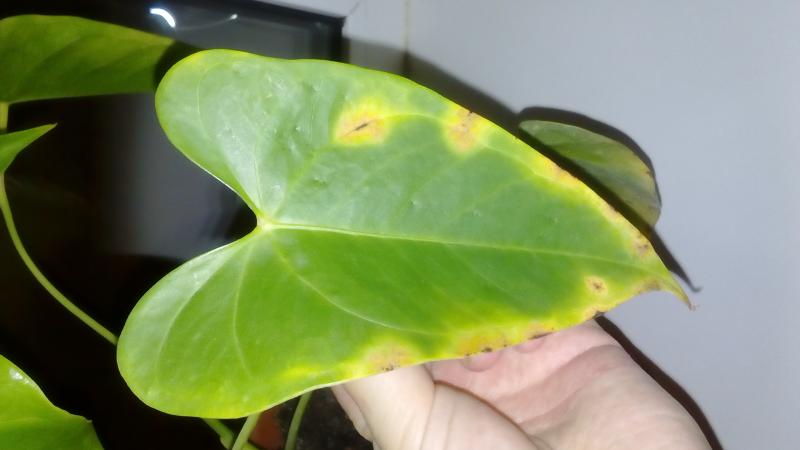

Yellow spots
On a note! It is possible to make an accurate diagnosis by the appearance of the sheet. With chlorosis, the veins remain green, and the leaf turns completely yellow.
Black spots
If the transplant procedure was carried out incorrectly or an unsuitable substrate for this type of substrate was used, black spots may appear on the anthurium.
The soil for this species is selected taking into account the individual preferences of the plant. For example, intended for bromeliads or orchids.
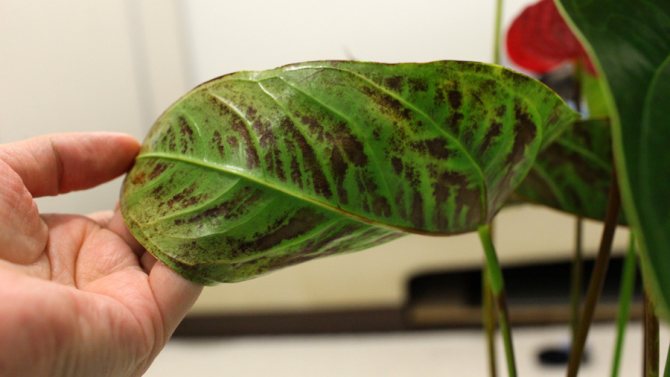

Blackening of the leaf
White spots
When anthurium is infected with powdery mildew, a white bloom appears on the leaves.
This disease occurs at high temperatures and high humidity in the room.
This disease is easily treated in the early stages with common fungicides.
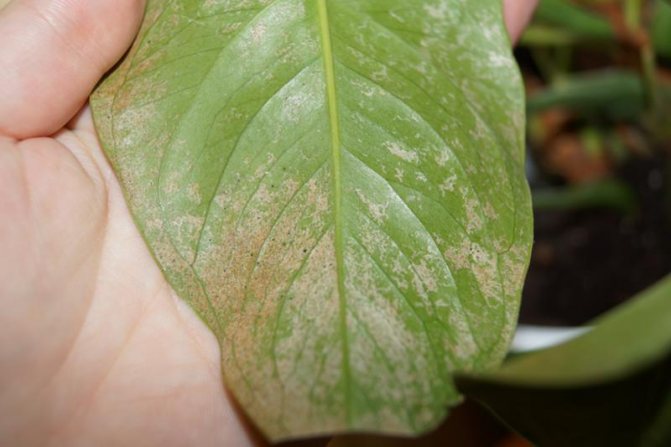

Powdery mildew
with my favorite plant?
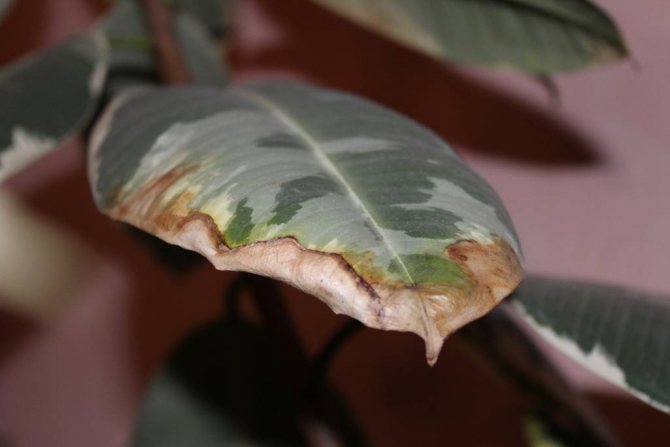

One of the most common problems that growers face when growing indoor plants is the appearance of dry spots on the leaves. They spoil the appearance of the plant, simply kill the decorative effect and create the feeling of a flower disease. To cope with this problem, first of all, you need to understand what are the reasons for its occurrence. In this case, you need to rely on the requirements for the content of each individual plant and be able to track unfavorable external factors that could provoke the drying out of the plant tips.
- Air is too dry. One of the most common and objective reasons for the appearance of dry spots on the leaves. Dry air is dangerous for tropical plants, and those that most need high humidity.Many people acquire a small dracaena, with leaves sticking upward, and when it grows up, they notice the appearance of blackened tips on the leaves. And then the question arises - why do the tips of the leaves dry in dracaena? The reason is trivial, and it is too dry air.
You can check the air humidity in your home using a home weather station or a special device. In an ordinary panel multi-storey building, the indicators are in the range of 24-30%, with 70% recommended for dracaena ... owners of spathiphyllum, orchids, ficuses and many flowering plants face the same problem.
- Rare watering. Dry brown spots on the leaves can often appear with insufficient or sparse watering. Unscrupulous watering leads not only to the appearance of dry spots on the leaves - this is only the first sign. In the future, the problems may worsen and the plant will become seriously ill.
- Intense sun. Dry spots on the leaves can be the result of an unnoticed sunburn in time.
- Excess or lack of fertilizer. Sometimes, with a prolonged shortage or excess of fertilizing, dry spots may appear on the leaves of plants. Moreover, dry areas can be at the tips or anywhere on the sheet.
- A very cramped pot. A plant whose roots are huddled in too tight a container may be depressed. Dry spots on the leaves indicate stress and the development of the disease.
- Poor irrigation water quality. Especially sensitive plants react sharply to watering with hard, chlorinated, not settled, too cold water. All of this can shock the root system, which will cause brown spots or dry tips on the leaves.
- Pest attacks. Houseplant pests often settle on the inner surface of leaves, where they can parasitize for a long time, remaining unnoticed by their owner. Small insects gnaw the leaves, suck the juice out of them, and dried spots appear at their places of stay.
How dangerous is yellowing of leaves
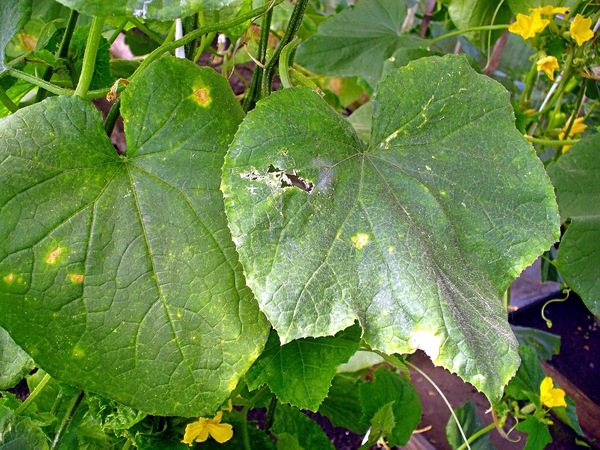

Spots on the leaves of cucumbers in a greenhouse or garden indicate that the plant needs help. If you ignore the appearance of yellow blotches or reddish areas, the lashes will begin to dry out or rot. And when the color change begins from the lower leaves at the end of the season, you do not need to think about pest control or treating the bush - it just starts to die off old leaf plates. If you plan to prolong fruiting, for example, in a greenhouse, then the old cucumber leaves in yellow spots are simply removed. In other cases, the plant needs to be treated.
Interesting Facts! Top dressing will help to rejuvenate the planting. Root: they retreat from the stem by 7-110 cm, add humus and add humus, and foliar - with hay infusion. Dry grass - wheatgrass, bluegrass, weeds - are soaked for 5 days in hot water, the volumes of the components are the same. Spray the whole plant 3 times.
Plant care rules
Anthurium is a capricious plant. Some of its species are grown only in a greenhouse. It is also important to consider when growing a plant and the fact that its juice consists of toxins that can adversely affect the human mucous membranes.
Features of anthurium care:
- It is recommended to grow a flower in partial shade or on a windowsill with diffused light, as it does not like bright lighting. At the same time, it is important to provide additional lighting to the anthurium in winter. Otherwise, the plant will not sprout flower stalks.
- In summer, the air temperature in the room should not exceed 25 degrees Celsius, and in winter the plant can develop at a temperature of 14-16 degrees.
- To prevent the anthurium from dying, it is necessary to avoid places with drafts.
- It is recommended to water the flower with lukewarm water. In summer, watering is carried out every three days, and in winter - once every seven days. The water remaining after watering from the pan must be poured out so that the roots do not rot.
- It is also important to ensure good humidity in the room where the flower is grown. Spray the leaves systematically, but in such a way that water does not get on the flowers.
- Feed the anthurium twice a month with a mineral solution or organic fertilizer. It is necessary to feed during flowering and active growth of the plant.
- Anthurium grows best in self-prepared soil. Mix humus (two parts) with leafy soil and peat (one part at a time) and sand (half part). Crushed brick or cones are added as drainage.
- It is important, after purchasing the anthurium, to transplant it into a new, suitable in size, pot with the correct soil.
At home, the plant can be propagated by cuttings. Cut the cuttings from the tops of the flower along with the aerial roots. Plant them according to the rules in prepared containers.
So that the plant does not disappear, it must be protected from the attack of aphids, scale insects, fungal infections.
Prophylaxis


It may be interesting Rules and features of growing pepper in the Urals Why are cucumbers soft or prickly in a greenhouse and in a garden? Early peas - early proteins
So that the seedlings of cucumbers do not disappear, it is advisable to listen to the following recommendations: follow the rules of crop rotation, regularly change the place for the beds. In order not to infect with fungal diseases, do not plant this crop after pumpkin.
Watering should be regular. Those who visit the site only on weekends should consider mulching so that the ground does not dry out. Top dressing is carried out without fail. Chemical compositions can be replaced with organic ones - add humus, chicken droppings, manure.
Many gardeners are wary of using chemicals on their backyards. But without spraying, it is unlikely that it will be possible to prevent yellowing of cucumbers. To stop the invasion of pests, spraying is carried out every 10 days - as soon as the first leaves appear on the sprout. The proportions of the composition: 1 liter of milk, 20 g of laundry soap, 30 drops of iodine per 8-10 liters of water.
Treating insects with tar, ammonia, decoction of onion peel or wormwood repels insects. A soda solution will help protect against rot - 2 tbsp. l. ha bucket of water. Spores cannot tolerate alkaline conditions.
Attention!
At the first signs of yellowness, regardless of the reasons, the whole plant is treated with a weak solution of potassium permanganate.
In advanced cases, folk remedies do not help. To protect the plant and preserve the harvest, it is advisable to give preference to biological drugs: Fitosporin, Trichodermin, Glyokladin, Gamair. These funds suppress the vital activity of pests and the activity of fungi, but do not pose a danger to humans.
Reasons for which leaves dry and become stained
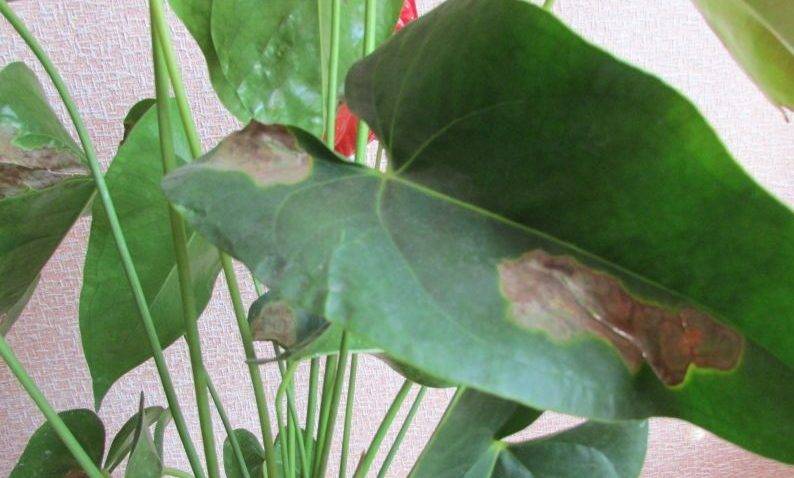

If mistakes are made with watering, the fertilizing schedule is violated, the room has excessively dry air or improper lighting of the plant, the leaves of the anthurium gradually dry out.
Often, the development and beauty of the leaves of a plant is affected by a sharp drop in temperature, as well as growing a flower in a cold room.
If the rules for growing a plant are violated, it begins to hurt and disappears. Therefore, it is important to know the main reasons due to which leaves of anthurium dry or become covered with spots of different colors.
Incorrect fertilization
The lack of nutrients is indicated by the slow growth of the plant, small young leaves. The leaves turn brown due to a lack of nitrogen, phosphorus or potassium, as well as calcium or magnesium.
It is recommended to feed the plant with liquid ready-made products. The affected flower is fed every week. As soon as the plant comes into force, feeding is reduced to once every 14 days.
With an excess of fertilizer, anthurium leaf plates can also change their color.To save the plant, transplant it into new soil, after flushing the roots.
Causes of leaf blackening
The following reasons lead to blackening of leaves in anthurium:
- the influence of direct sunlight;
- drafts;
- wrong air temperature;
- the presence of calcium salts in the substrate.
If the leaves of the anthurium turn black due to a draft, the pot must be moved to another cozy place.
When blackening the leaf plates due to sunlight, make a shaded place for the flower. It is important to provide the flowerpot with diffused sunlight or partial shade.
Pest attack


If the leaves are covered with yellow spots and begin to curl up, it means that aphids attacked the plant. To save the plant, treat it with special products or tobacco tincture.
If the shoots are covered with cracks and the leaves are spots, the flower is struck by a mealybug. To destroy it, karbofos is used.
Dark spots on the leaves of anthurium appear due to the attack of the scale insect. Pests must be removed, and the plants must be treated with laundry soap mixed with kerosene.
The appearance of brown spots
Anthurium produces brown spots on the leaves due to the following reasons:
- improper feeding. It is recommended to fertilize with fertilizers with balanced substances;
- if the room temperature is too low, the leaves become covered with small brown dots.
If brown spots were noticed, the stem may have been damaged by a mealy worm, which can be destroyed with special chemicals.
The appearance of yellow spots
Anthurium leaves turn yellow due to lack of light in winter. Watering the plant with water with chlorine and heavy metal oxides also leads to this phenomenon. To avoid the yellowness of the leaf plates, it is recommended to water the flower with rain, melt or settled water.
If water accumulates in the pan, the roots of the flower rot and the leaves turn yellow. It is important to moisten the soil moderately, and drain excess liquid from the pan.
A small potted plant can also produce yellow leaves. In this case, it must be transplanted into a large container.
Causes of leaf drying
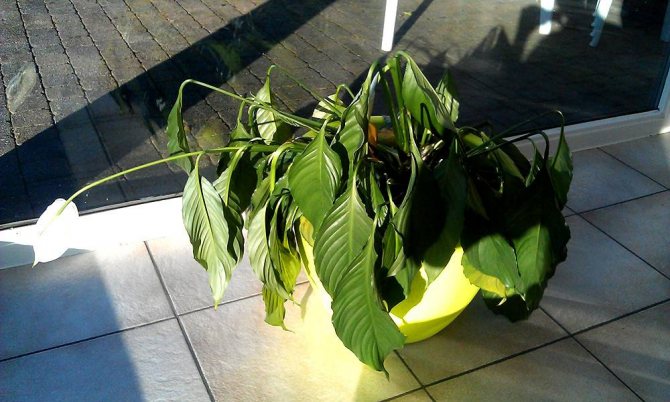

Anthurium leaves dry due to dry air, insufficient watering, diseases or aphids.
The frequency of watering depends on the season. The soil should dry out by a third of the pot between waterings. To increase the humidity of the air, spray the leaves with water daily.
In the case when the leaves dry at the edges, and then begin to dry completely, it means that the plant has suffered from anthracnose. Treat with a systemic fungicide to eradicate the disease.
Age changes
Most often, leaf plates turn yellow in anthurium due to aging. Age-related changes affect more the foliage, which is closer to the ground.
Yellowness spreads over the entire leaf area, due to which it loses its elasticity and juiciness, acquires a brown color. After a while, it falls off on its own, if it is not removed earlier.
If the anthurium is well and properly looked after, the loss of old leaves does not harm the plant, since young healthy leaves begin to grow at the top of the stem.
Since yellowing leaves do not benefit the plant, but only take away strength, it is best to remove them on time. If you remove old leaves, the flower will develop better and become more attractive.
To cut off the leaves that have become obsolete, it is recommended to treat scissors or a knife with alcohol so as not to infect the stem. Sprinkle the cut areas on the trunk with fine charcoal. In the case when the leaf turns yellow, but has not lost its juiciness, it is impossible to cut it off by hand so as not to injure the stem, so use only a sharp tool for this purpose - a knife.
Appearance
Examine the foliage for the size, shape, and location of the brown spots. This will provide valuable clues to the problem.Brown spots may appear along the edges of the leaves, at the tips, or as round or shapeless spots in the middle of the leaf.
Water and fertilizers
Look for signs of insufficient watering, which is causing brown spots at the edges of the leaves, wilting of foliage, and poor growth. Place the plant pot in a bucket of lukewarm water and soak until the bubbles stop rising to the surface. This may take 30 minutes, depending on the size of the plant. Water the plant regularly.
Check the soil for white deposits - this is a sign of over-fertilization. Do not fertilize plants during periods of dormancy or reduced growth, such as in winter. An excess of fertilizer causes brown spots on the leaves. Resume feeding the plants in the spring when the plants are still growing again.
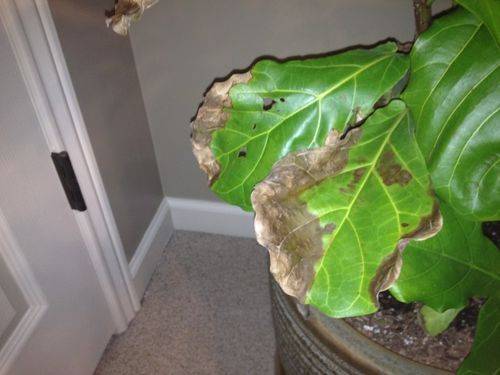

Humidity
Low air humidity makes the leaves brown and crunchy at the edges. Provide adequate ventilation and keep plants away from heating systems. Place a tray of gravel under the plant, filled with 1-2 cm of water to increase the humidity around the plant.
Cold
Plants may develop brown spots if their leaves touch the ice-cold window pane. Although the temperature may be appropriate during the day, it usually drops at night, and then the contact of the leaves with the glass will cause brown spots. Keep plants away from windows, especially at night. Never draw curtains between a window and plants during cold weather.


sunlight
Plants can also suffer from direct sunlight. Usually the leaves turn white or yellow from overexposure to light, but sometimes brown spots appear. Remove plants from direct sunlight, gradually adding light again, but less.
Fungal stains
Traces of plant contamination by a fungus are dark spots in the middle of the leaf. This is usually the result of over-watering. Isolate the plant and provide adequate air circulation. Do not spray the plant if you suspect it has a fungal infection. Remove infected leaves and loosen the soil to allow good air circulation. The problem usually goes away on its own without requiring the use of fungicides.


How to get rid of with folk remedies
When swollen reddish spots appear on the currant before the fruit ripens, alternative methods of treatment will come to the rescue. To cure a plant from a pest, decoctions based on chamomile or celandine will help. Garlic, tobacco, makhorka or ash will also help.
Soap solution
When preparing any solution, it is recommended to add soap: household or tar to increase the adhesion of the liquid. The prepared composition is sprayed over the bushes so that the liquid gets not only up, but also down the plant. Learn about aphid laundry soap here.
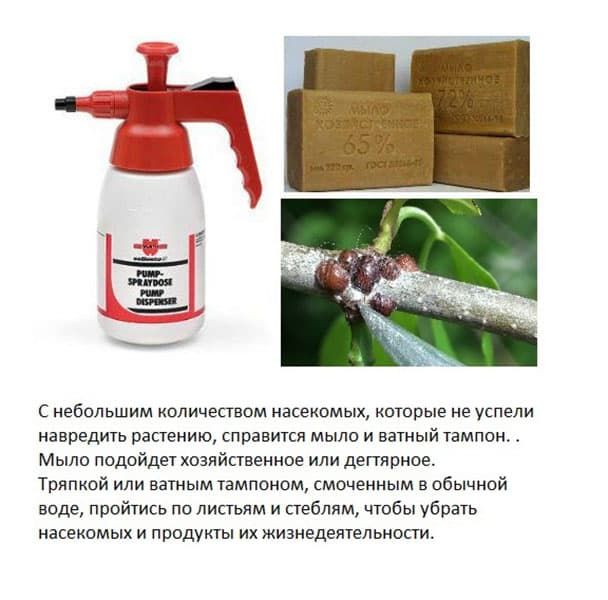

How to prepare a classic ash and soap solution that kills pests:
- Laundry soap calves into several parts. One of them is rubbed finely on a grater and filled with three liters of water, infused for a day.
- Ash in the amount of 300 g is poured into 2 liters of water, boiled for half an hour, cooled, filtered.
- The soap is mixed with an ash solution, filled with water in the amount of 5-8 liters.
This medicine is suitable for processing currants, raspberries, strawberries. Such a decoction not only protects against insects, but also helps with the supply of potassium.
Wood ash
Wood ash also helps to get rid of all kinds of stains. Wooden ash is prepared in the amount of half a glass. Pour or pour in a liter of water and cook for 30 minutes. Then water is added, up to a liter. Tucked away in a cool warm place for the day. Next, you should strain, pour a spoonful of liquid soap into the mixture, a little grated. This product is placed in a bottle and sprayed with bushes. Read about ash as fertilizer here.
Green soap
Professional gardeners know about Green Soap. This substance is non-toxic, it will not harm the tree. Acts actively in the presence of living organisms. The body of the insect is enveloped in a fatty potassium film that blocks its breathing. For 10 liters of liquid, 300 grams of green soap is used. A medicinal agent is used in parallel with fungicides. For this, both preparations are mixed in one container in a ratio of 30 g of soap and 2 g of vitriol. Also used in equal proportions with baking soda.
Garlic
Prepared with tobacco dust. Pour 200 g of dust into one liter of water, to which a few cloves of garlic are added. The mixture is boiled for 30 minutes. Water is topped up until the liter reaches exactly. It is infused for a day in a cool place. After that, it is filtered, a teaspoon of liquid soap with 20 grams of fine laundry soap (pieces) is poured into the garlic broth. Place the mixture in a spray bottle and process the plants. How to pour the garlic with ammonia read in this material.
What are brown spots on the leaves of an apple tree?
Brown specks on foliage are signs of fungal infection.
They can be symptoms of the development of a dangerous fruit tree disease.
Many gardeners want to know when they see brown spots on an apple tree - what is it?
There are several options for the causes of the manifestation of the lesion:
- The flea is a copperhead.
- Lack of potassium in the soil.
- Scab.
To start the apple tree treatment, you need to know exactly why brown spots appear on the leaves of the apple tree. Each type of disease requires its own treatment system.
Apple pest - insect honeydew, another name - listobloshka, affects various fruit trees. Bulging spots appear on the leaves. Insects multiply quickly, feeding on fruit crowns, and easily endure winter cold.
Potassium is especially important for fruit seedlings during the growth of the first spring shoots. The lack of potassium is reflected in the change in the color of the leaves.
Brown spots often affect trees if the soil is sandy. You can see what brown spots appeared on the leaves of the apple tree photo of the deficit state:
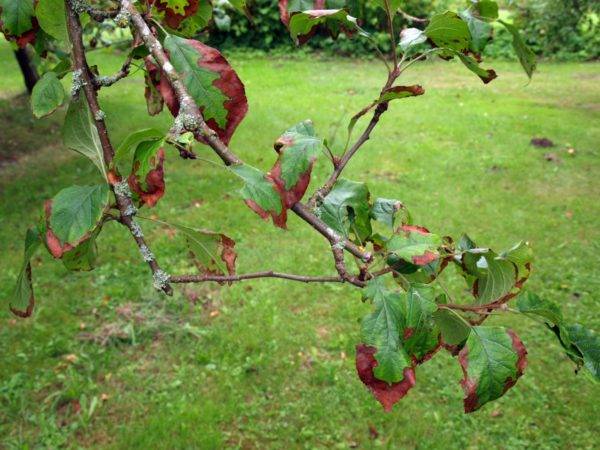

Brown spots appear on the leaves from a deficiency of mineral fertilizers.
Pests
The gardener is obliged to constantly inspect the bushes for the appearance of currant pests on them. Insects, feeding on buds, leaves, bark, cause irreparable harm to plants and they dry out. The most common pests:
- Aphids;
- Ants;
- Currant glass bowl;
- Currant shoot gall midge;
- Zlatka;
- Kidney, spider mite.
With them it is necessary to carry out a constant struggle, if they are already wound up in the garden. But it is still better to prevent this phenomenon by taking certain preventive measures:
- Cut and burn dying and dry shoots;
- Shake off the currant goldfish until it flies. This is done early in the morning;
- Arrange trapping belts for ants;
- Prevent the spread of weeds near currant bushes;
- Rake the leaves under the plants in autumn and burn them.
Aphids and ants
Aphids are small insects related to piercing - sucking pests. In the spring, larvae emerge from the eggs, which feed on the sap of leaves and shoots. As a result, they are deformed and may die. Ants feed on the secretions of aphids. Therefore, as soon as the summer resident notices the increased activity of these insects scurrying back and forth along the branches of the plant, it means that aphids have appeared on the bushes.
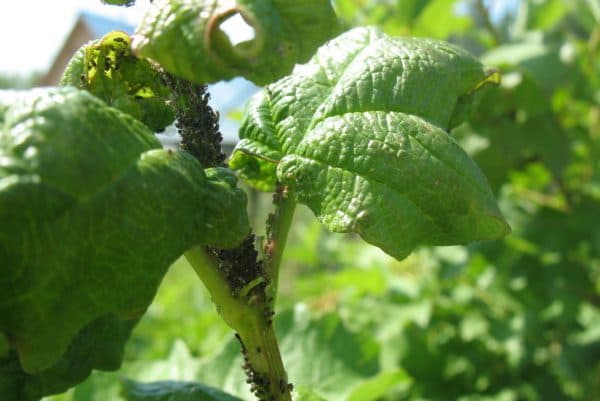

The ants carry aphid eggs and larvae to nearby bushes, thus infecting healthy plants. Therefore, it is necessary to fight these insects.
You can destroy aphids by spraying the bushes with a 4% solution of laundry soap (you need to take 400 grams of the product for 10 liters of water). If the colonies are very large, then the shrubs are treated with 0.2% Metaphos or Karbofos.
These funds should not be applied twenty days before harvest.
They also attract the natural enemy of aphids - the ladybug.These beneficial insects can settle in the garden if chamomile, basil, dill grow there. With small accumulations of pests, the bushes can be treated with an ash solution (a glass of ash in a bucket of water).
Ants are removed with special products that are sold in plant protection stores. Or you can remove the top of the nest and move it with a shovel farther from the plantings, and fill all the remaining underground passages with water. This link will tell you about the description of the Minusinski tomato variety.
Spider mite
Currants are very affected by kidney and spider mites. The first one gnaws a bud from the middle and a leaf or inflorescence does not appear in this place. And the activity of the spider web leads to the drying of the leaves. The first sign of damage to the bush is the formation of a thin whitish cobweb on the vegetative mass. Then white dots appear on the leaves, which, expanding, completely cover the leaf blade. It becomes lighter as a result of the destruction of chlorophyll and falls off. You can fight ticks by treating shrubs in early spring with Thiofos, as well as using Karbofos, Fosfamid, Floromite, Oberon, Apollo, Nisoran and others.
Some summer residents say that the tick can be destroyed by constantly irrigating the shrubs from above with water. This insect does not like a humid environment.
Chemicals need to be changed more often as the mite adapts to them.
Kidney mite
A very small insect, barely visible to the naked eye. In early spring, the larvae emerging from the eggs concentrate in the buds. Ticks suck out the juice, and leave enzyme substances that disrupt the growth of future leaves and inflorescences. Several generations develop during the summer. Signs of the appearance of a fruit mite: the buds become rounder and larger than normal. Their appearance resembles a miniature head of cabbage.
Control measures: in early spring, currants can be sprayed with DNOC, or Thiofos. When the tick has hit the currant bush completely, it is better to uproot and burn the plant. There are no effective methods of dealing with this pest.
Glass-maker
The currant glass bowl is a bluish-black butterfly with transparent wings. Begins to fly in May, laying eggs on shoots. After about 10 days, caterpillars appear, which make wormholes, penetrating deep into the shoots. After a while, the damaged branches dry out. Agrotechnical methods of control: spring and autumn inspection of the garden, cutting and burning of dying and dry branches.
The reasons why the leaves of the apple tree turn brown
The scab changes the foliage of the apple tree... Nothing remains of the pleasant green color.
Further, brown spots appeared on the leaves of the apple tree. They can be almost olive-brown.
Fungal disease affects trees early in summer. The rate of development of the lesion is very high. The leaves take on a painful brown color and gradually die off.
The disease does not stop only at the defeat of the leaves, goes to shoots, ovaries and fruits.
Conditions for the development of the fungus:
- Improper abundant watering;
- Frequent rainfall;
- Morning fogs;
- Abundant dew.
In winter, the fungus does not die, he hides in fallen plants.
It is important to monitor the condition of treesespecially on rainy and foggy days, so as not to miss the first signs of scab:
- Oily stains will become visible on the leaves.
- The green tone will become lighter in places.
- The spots gradually, but quickly enough, turn brown,
- covered with a velvety bloom.
See information from experts about scab:
Control measures for septoria
Treatment of adult plants affected at the beginning of the growing season does not give good results. It is recommended to remove diseased tomatoes, and treat the remaining and soil in the garden with fungicides.
Fruiting of tomatoes with minor lesions of the lower leaves in the middle and end of the season can be prolonged. To do this, cut off diseased leaves, treating the wounds with a 0.5% solution of copper sulfate.
Drugs
To date, there is not a single chemical drug that is 100% effective against septoria. But there are fungicides approved for tomatoes and approved to fight other fungal diseases. They inhibit the development and spread of septoria.
Before processing in the greenhouse, they reduce humidity and eliminate condensation, and in the open field they are guided by the weather.
Chemicals:
- Thanos 50, c. g.,
- Title 50, v. g .;
- Quadris 250 SC, k.s .;
- Acrobat MC, v. g .;
- Ditan M-45, p. P.;
- Acidan, p. P.;
- Metaxil, p. P.;
- Skor 250 EU, c.e .;
- Ridomil Gold MC 68 WG, v. g .;
- Poliram DF, v. g.
The dosage of the drug and the consumption rates of the working solution are indicated by the manufacturer in the instructions.
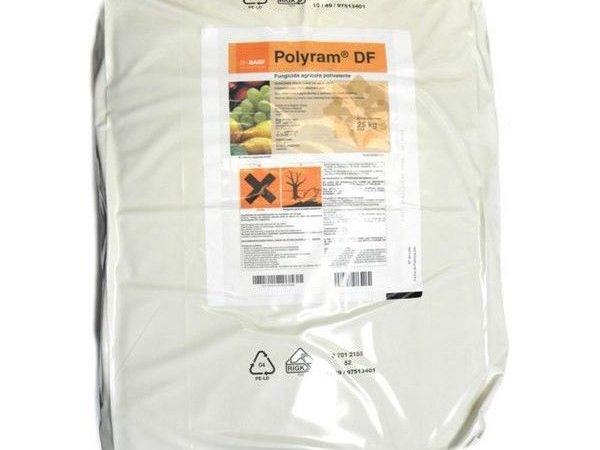

For processing plants, choose the morning or evening hours, when rain is not predicted. The working solution is prepared immediately before use.
The measured dose of the drug is dissolved in a small amount of water, stirring constantly, and poured into the sprayer tank. It is pre-filled with water halfway. Then add water to the full volume of the solution.
Work in closed clothing, gloves and a respirator. When processing tomatoes, it is important to achieve complete wetting of the entire surface of the plant, affecting the surface of the garden.
The effectiveness of treatment is achieved only if the frequency and intervals of treatments recommended by the manufacturer are observed.
Why do apple leaves turn brown and dry?
Scab disease doesn't just spoil the leaves. Gradually, becoming completely brown, they dry out, practically blacken and fall off.
The tree becomes terrible, bare. The scab does not leave without its attention the fruits of the apple tree. They take on an ugly appearance, fall off, not having time to mature and enter into growth.


Scab-infested trees.
Soil tillage after infection
Even in cases of single infection of the bushes, the soil is carefully cultivated. Collect and destroy all plant residues together with root particles. The earth on the site is dug up as deep as possible, trying to ensure a complete turnover of the formation.
For disinfection, chemical or biological preparations are used, and, if possible, steamed with boiling water.
Chemicals:
- bleach - 200 g per 1 m² (processed in autumn, the drug is embedded in the soil);
- formalin 40% - 200 ml of the solution is diluted in 10 liters of water and the soil is shed, consumption per 1 m² is 20 liters (cover with a film for 3 days, then remove and harrow the soil, apply 15-20 days before planting the plants in spring);
- copper sulfate - use a 2% solution of copper sulfate, consumption per 1 m² - 10 liters (preferably applied in the fall or 30 days before planting, no more than 1 time in 4-5 years);
- fungicide TMTD - used in the form of powder and suspension solution, on 1 m² distribute and seal 60 g of powder or spill 10 liters of 0.6% solution.


A less effective way is soil treatment with biological preparations. Its advantage is absolute harmlessness to soil microorganisms and to humans. Preparations: Fitosporin M, Gamair, Alirin, Trichodermin. Biofungicides are used according to the instructions.
Another option that guarantees the destruction of most soil pathogens is to spill it with boiling water. Consumption for 1 m² - 10 liters. The surface of the soil is covered with a dense plastic wrap, left for one day. Then they dig up the ground. The procedure is repeated 3 times.
The edges of the leaves turn brown
If, the leaves of the apple tree are brown spots - this is often a sign tree damage during frosts:
- The sheet plate does not change completely, but only along the edges.
- Gradually, under good weather conditions, the tree recovers.
- The green color returns to the crown.
Another reason when the edges of the leaves turn brown on the apple tree - lack of potassium.
Stains spoil the appearance of the apple tree with a lack of copper and manganese... The owner of the garden purchases special organic fertilizers. The optimal choice of fertilization is autumn.
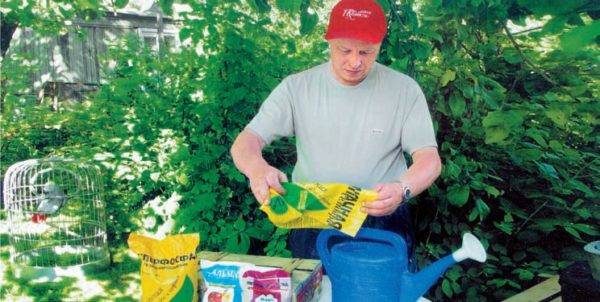

Mandatory fertilization.
During the winter period, the garden will collect the necessary microelements for proper development and fruiting.
They feed on the area of the root system, that is, under the trunk and around the tree, approximately along the diameter of the crown.
The reason why there are brown leaves on the apple tree, there may be a large amount of nutrients, their excess... Everything should be normal.
conclusions
Brown spots on currants, drying out of leaves and shoots may appear under the influence of such factors:
- Weather. The bushes dry out when the heat is intense and there is no rain for a long time.
- Improper watering. Both high humidity and a long period without irrigation can lead to the death of the plant.
- Diseases. Disease weakens plants. Some bushes may simply show low yields, while others die.
- Invasion of pests. Insects such as aphids, mites, and glassworms feed on buds, leaves, young shoots, which leads to the death of currants.
Branches and leaves dry up only from the lack of attention of the summer resident to the plants. After all, by carrying out regular preventive measures, you can prevent pests and diseases in your berry. And by balancing watering and feeding, protect the roots of the currant from drying out or waterlogging. All these rather simple steps will help keep the health of the currant and its fruiting at the desired and desired level. Read about hybrid varieties of tomatoes for greenhouses here.
Treatment methods
Each type of disease requires its own treatment. If brown spots appear on the leaves of the apple tree, then knowing the reason, you can apply the following measures:
- With copperhead fight with the help of a specially created solution - karbofos. Another method is fumigation, tightening the crown with tobacco smoke.
- The required amount of potassium can be provided to the garden with an annual seasonal feeding. To do this, take potassium sulfate or ordinary wood ash. Potassium sulfate can be purchased at specialized stores. Its recipe is quite simple - 100g of the substance is diluted in 1 bucket of water. Ash will have to work a little. Dissolve 300 g of ash in a bucket of water and boil. After settling, a soap solution is added to the mixture.
Measures for the prevention of phyllostictosis and brown spot of apple trees
To prevent this disease, you should choose resistant varieties (Solivarskoe noble and Batul), collect and burn infected leaves.
Moreover, keep the balance of nutrients when applying fertilizers, in particular, observe the application rates of nitrogen-containing fertilizers.
To increase the resistance of trees to infections, arrange foliar dressing with polymicro fertilizers, for example:
- Uniflor-micro,
- Quotes,
- Aquadon-micro
in combination with immunomodulators, such as:
- Immunocytophyte,
- Humates,
- Silk,
- Zircon,
- Narcissus,
- Eco-gel.
The control of sucking pests such as aphids and thrips, which contribute to the transmission of infection, can also be considered a preventive measure against phyllostictosis.

